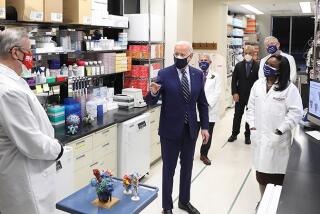Federal Officials Challenge AIDS Drug Monopoly
- Share via
WASHINGTON — In a move that could significantly reduce the cost of AZT, the only approved AIDS drug, the National Institutes of Health said Tuesday that it helped Burroughs Wellcome Co. develop the patented medication and wants authority to license other companies to market it.
NIH Director Bernadine P. Healy said in a statement that the National Cancer Institute, one of the NIH’s constituent research agencies, should have been named a co-inventor of the antiviral drug and that Burroughs Wellcome’s monopoly on the drug should be broken.
Healy said that NIH may grant a non-exclusive marketing license requested by Barr Laboratories Inc., another private company, if Barr prevails in a pending court challenge of the Burroughs Wellcome patent.
“NIH is contemplating the granting of this license so that the company legally would be able to market AZT if it is ultimately determined, in litigation between Barr and Burroughs Wellcome, that the government is entitled to inventorship status,” Healy said. “In that event, competition would result in a lower price for AZT.”
The cost of AZT has been an issue since the Food and Drug Administration approved it in 1987 as the first drug to treat the underlying viral condition that causes AIDS. When the drug was introduced, it cost the average AIDS patient between $8,000 and $12,000 a year.
Under pressure from AIDS activists, members of Congress and others, Burroughs Wellcome twice lowered the price of the drug. The cost of AZT therapy was reduced further when studies demonstrated that lower dosages were just as effective as the higher levels used in earlier studies. AZT currently costs a typical patient about $3,000 a year.
Some experts believe that the cost of the drug could be reduced by one-half to two-thirds if other manufacturers are allowed to market AZT.
Healy said that her agency and the drug company do not disagree about the substance of their scientific contributions to the development of the drug, also known as zidovudine, but that they differ over whether the National Cancer Institute should be listed as a co-inventor.
Healy said that National Cancer Institute investigators used state-of-the-art lab techniques in 1985 to evaluate the drug and determine its therapeutic value against HIV.
Burroughs Wellcome and the government were named in March as co-defendants in a lawsuit filed by Public Citizen, a public interest group representing the People with AIDS Health Group and several AIDS patients who challenged the validity of the patent.
Burroughs Wellcome has acknowledged collaborating with the National Cancer Institute in development of the drug, but the company, based in Research Triangle Park, N.C., maintains that its scientists were the first to think of using AZT as an AIDS therapy.
Barr Laboratories, a Pomona, N.Y., drug maker, is seeking FDA approval to market AZT as a generic drug therapy for individuals who are infected with the human immunodeficiency virus but have not yet developed symptoms of the disease.
Barr has submitted a separate request to the NIH for a license to market the drug if it turns out that NIH has rights to the patent. But, even if it receives the NIH license, it still will need FDA approval to market the medication.
“It’s a long overdue recognition of the government’s role in developing this drug,” said Jeff Levi, director of governmental affairs for the AIDS Action Council. “It should also open the way for competition in marketing the drug, which should mean wider access to the drug for many people with AIDS.”






